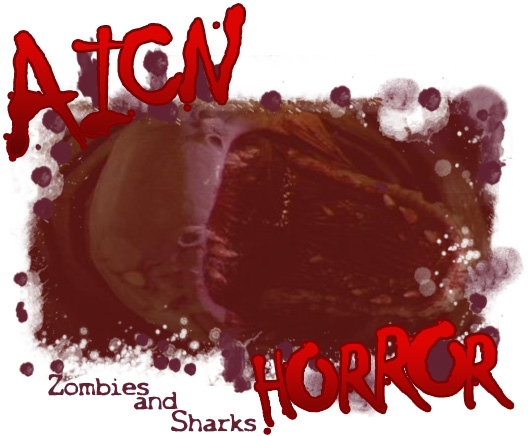
Greetings, all. Ambush Bug here with another AICN HORROR: ZOMBIES & SHARKS column. So my fellow reviewer for AICN COMICS BottleImp is a fan of all things Lovecraft. He got his hands on a new anthology called BLACK WINGS OF CTHULHU: TWENTY-ONE TALES OF LOVECRAFTIAN HORROR and asked if he could review it for AICN HORROR. I thought it was a bully idea and even suggested we do a whole column on Lovecraft. I’m nowhere near the expert Imp is, so I invited him to share a couple of his favorite Lovecraft films and tagged a few of my own on as well. The result is the article you’re reading now. I know this is just the tip of the iceberg when it comes to Lovecraftian cinema, but maybe we’ll cover more in an upcoming AICN HORROR: Love Lovecraft column. Until then, enjoy the tentacley goodness…
(Click title to go directly to the feature)
BLACK WINGS OF CTHULHU: TWENTY-ONE TALES OF LOVECRAFTIAN HORROR Anthology Novel
IN THE MOUTH OF MADNESS (1994)
DAGON (2001)
THE CALL OF CTHULHU (2005)
HEADSPACE (2005)
WHISPERER IN THE DARKNESS (2011)
And finally…Leonardo Manna & Michele Boitticelli’s A LOVECRAFT DREAM
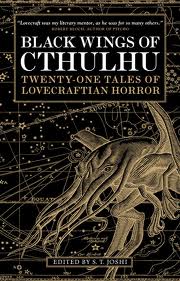
BLACK WINGS OF CTHULHU: TWENTY-ONE TALES OF LOVECRAFTIAN HORROR Anthology Novel
Editor: S.T. JoshiPublisher: Titan Books
Reviewer: BottleImp
When you think about it, there’s no greater honor that can be bestowed upon an artist than his name being turned into an adjective. It means that this person has created something so new, so unique, that all the words in the English language that have ever been written are not enough to describe what this artist has wrought. The most perfect description of the artist’s work can only be a naming of the artist himself…and so we readers of weird fiction now have the word “Lovecraftian” firmly entrenched in our lexicon. The strange thing about this particular term, however, is that Lovecraftian can mean very different things depending on the mindset of those who use it. There are some who look at the surface trappings of an H.P. Lovecraft story and see no further; for these unfortunates, Lovecraftian means an ancient tome of unspeakable evil (usually the Necronomicon, but not always necessarily so), a scholar who delves too far into said text to remain sane, a giant frog (or bat, or octopus, or…) who can be summoned by a string of incomprehensible gibberish (and likewise banished by variations on the same)…and tentacles, tentacles, tentacles. During Lovecraft’s brief life and the decades that followed his death, this type of shallow emulation of the man’s work dominated the bulk of so-called Lovecraftian fiction. There were, of course, exceptions to the rule, penned by Bloch, Kuttner, Howard and a handful of other skilled authors, but the majority of the work was comprised of HPL pastiches that followed the same “book, scholar, seafood monster” formula.
That all began to change as time moved on, and the bright and shiny optimism of the 1950s gave way to a darker, more cynical mood of those living under the threat of nuclear war. The cynical counterculture who discovered J.R.R. Tolkein’s “Lord of the Rings” and embraced it for Tolkein’s clear delineation of Good and Evil was mirrored by the darker undercurrent who read Lovecraft’s descriptions of Elder Gods from the vast, unknowable gulfs of space and time, who read of Man’s impotence in the face of terrors his mind could not comprehend, and these readers responded to HPL’s bleak worldview with a vengeance. Lovecraftian fiction moved away from the simplistic pastiche and expanded in scope and style. The new disciples of Lovecraft’s so-called Cthulhu Mythos relegated the tentacles back to their rightful place as window-dressing and focused on those essential themes of cosmic horror that make HPL’s work the iconic, powerful force that it was and remains today. And we readers who eat up Lovecraftian fiction have been blessed with numerous novels and anthologies that represent the best of this school of writing, most recently S.T. Joshi’s Lovecraftian anthology BLACK WINGS OF CTHULHU. This is the good stuff, people.
The stories within encompass a wide range of storytelling styles, but all share that key element of expressing the sense of cosmic horror that HPL created. The real joy in reading such a collection is seeing how each author approaches this theme. There are some who don’t stray too far from Lovecraft in their own work—Donald R. Burleson’s “Desert Dreams” comes closest to skirting pastiche territory in writing style, but there are enough original ideas in the story to thankfully keep from falling into that trap—while in some stories, the Old Gent himself makes a cameo appearance. Three authors used Lovecraft’s seminal “Pickman’s Model” as the jumping off point for their own tales, though all three vary greatly in execution. “Pickman’s Other Model (1929)”, by Caitlin R. Kiernan, puts a twist on the story by giving the reader a more intimate glimpse of Pickman’s ghoulish subject matter. Brian Stableford’s “The Truth About Pickman” honors the Lovecraftian trope of degenerate family histories while putting a pseudo-scientific spin on the interbreeding of Pickman’s ghouls, while W.H. Pugmire takes a different tack with the surreal and dreamlike gothic-tinged horror of “Inhabitants of Wraithwood.”
HPL pops up as a ghost—or is he?—in Jonathan Thomas’ “Tempting Providence.” Like Lovecraft himself, Thomas’ protagonist laments the loss of the Providence of his youth to the cold hand of modernity, but his real problem is much graver in this homage to Lovecraft’s “The Haunter of the Dark.” HPL as a specter makes another appearance in Sam Gafford’s sadly poignant “Passing Spirits.” The narrator of this tale sees not only Lovecraft but many of his characters as well as he slowly succumbs to cancer, musing that all the horrible monstrosities of the Mythos are a more comforting menace than the cold, hard reality of his disease. Jason Van Hollander expands upon the notion of casting Lovecraft as a player in his own fiction by admitting HPL’s mother into the cast of characters in “Susie,” suggesting that Lovecraft’s Old Gods were something of a family affair. My favorite use of the writer as character in this anthology, however, comes from Ramsey Campbell’s “The Correspondence of Cameron Thaddeus Nash,” cheekily billed as “Annotated by Ramsey Campbell.” Campbell purports to have discovered a lengthy series of letters from Nash to Lovecraft, and presents this one-sided correspondence to the reader. Nash starts off as a slavering fan and admirer of Lovecraft’s work, especially his dream writings, and sends his own prose to HPL for critique and possible publication. Things between the two go sour after Nash’s work is mysteriously lost in the mail, and the tone of the letters turn from adoring to nasty. It’s the story of the obsessive stalker, and Campbell masterfully shifts the mood from Nash’s early, slightly pathetic adoration to the sheer silliness of Nash's later, petulant criticisms of the author he once idolized. But this uncomfortable humor drops away at the end, and Campbell leaves the reader with an uneasy sense of dread that lingers in the mind after the last words are read.
But Lovecraftian fiction need not have a guest spot from the man himself to be effective—in fact, some of the best stories in this anthology carry not one mention of the man, his Mythos, or any of the familiar New England locales. Mollie L. Burleson’s “The Dome” brings the idea of cosmic horror from the oceans to the middle of the New Mexican desert; likewise William Browning Spencer’s “Usurped”—though both stories expertly juxtapose their arid settings with Lovecraft’s fascination with the ocean and its mysterious depths. Urban environments provide the backdrop for other tales; Michael Shea adds another story to his catalogue of Urban Lovecraft with the excellent and evocative “Copping Squid,” while Laird Barron’s “The Broadsword” takes Lovecraft’s ideas of the Old Ones usurping humanity from the farmlands of Massachusetts to an apartment building in Pennsylvania. Likewise Philip Haldeman’s “Tunnels,” which also features the residents of an apartment building defending themselves from an ancient, unfathomable evil. Other stories touch on Mythos tropes, but manage to do so without invoking them by name—it becomes a treat for the reader to find those tasty Lovecraftian tidbits sprinkled here and there, like being a member of a secret organization whose signs and symbols are given to only a select few. “Denker’s Book,” by David J. Schow, is a post-apocalyptic tale told by a narrator (who, in best Poe and Lovecraft tradition, can no longer be called strictly sane) who describes a device created to open up a dimensional warp—a device powered by an unnamed, blasphemous book that those of us in the HPL club know can only be the Mad Arab’s infamous tome. Joseph S. Pulver, Sr. delivers a stylistic 180° from the usual Lovecraftian fiction with the rapid-pace, almost stream-of-consciousness crime fiction prose of “Engravings.” Pulver’s protagonist may not recognize his client Mr. Phoenix for who he truly is, but we know what Egyptian décor, midnight-black skin and the sight of Phoenix’s cats licking his hands all adds up to, don’t we? Darrel Schweitzer’s “Howling in the Dark” perfectly encapsulates both Lovecraft’s Mythos deities and his eerie Dream Cycle writing, again without ever name-dropping.
That’s not to say that one needs to incorporate Mythos details in order to write Lovecraftian fiction (or, for that matter, needs to have intimate familiarity with the Mythos in order to enjoy this type of work). Some of the best stories in this volume capture the tone of Lovecraft’s work without any of the familiar trappings. Nicholas Royle spins a moody story of madness in “Rotterdam,” while Michael Cisco’s “Violence, Child of Trust” presents a variation of HPL’s obsession with the ability of true horror to become a part of a family’s lineage. For those looking for a less cerebral story with a little more in-your-face horror, Norman Partridge’s “Lesser Demons” gives the reader a tale that would feel right at home in any collection of creature feature, post-apocalyptic wasteland, or zombie horror genre fiction. Sure, there’s a mysterious book of arcane knowledge—but just look at those ghoulish kids digging up the cemetery for a little snack!
While wading through this array of horrors, it’s easy to get a little overdosed on gloom and doom. Thankfully there are those writers who add a bit of light to the pervading sense of darkness, who realize that just ‘cause eldritch entities are looking to devour humanity, that’s no reason to be so damned serious all the time. The lighter side of Lovecraft comes courtesy of Adam Niswander’s “An Eldrich Matter,” wherein the transformation into one of the half-breed Deep Ones comes as more of a nuisance than true horror. And Michael Marshall Smith provides a wry look at one of the strangest (and potentially horrific) mid-life crises ever in “Substitution.”
It’s a good time to be a Lovecraft fan when there are anthologies such as BLACK WINGS that prove that HPL’s work provides ample inspiration for generations of writers of weird fiction. S.T. Joshi has assembled a remarkable collection of varied and unique voices that will be a delight for any reader who responds to their shared themes of cosmic horror. The best news? A second volume of BLACK WINGS OF CTHULHU is coming in 2013. It seems as if Lovecraft’s legacy will endure as long as the vast reaches of space and time remain unfathomable and enthralling.
When released from his bottle, the Imp transforms into Stephen Andrade, an artist/illustrator/pirate monkey painter from New England. He's currently hard at work interpreting fellow @$$Hole Optimous Douche's brainwaves and transforming them into pretty pictures on AVERAGE JOE, an original graphic novel to be published by Com.x. You can see some of his artwork here.
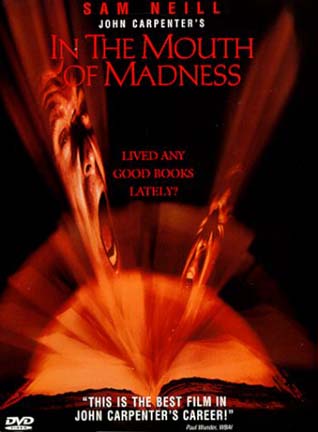
IN THE MOUTH OF MADNESS (1994)
Directed by John CarpenterWritten by Michael De Luca
Starring Sam Neill, Julie Carmen, Jürgen Prochnow, Charlton Heston, David Warner, John Glover, Bernie Casey, Frances Bay
Reviewed by BottleImp
If I had to pick my favorite Lovecraft adaptation, it would be a close tie between Stuart Gordon’s DAGON and the wonderful silent film THE CALL OF CTHULU made by the H.P. Lovecraft Historical Society. But my all-time favorite Lovecraft movie that isn’t adapted from Lovecraft’s work has to be John Carpenter’s IN THE MOUTH OF MADNESS. Very few films tap into that weird sense of the blurring of fantasy and reality created by reading Lovecraft’s work, but here Carpenter does so with a marvelous sense of atmosphere, wit and dark humor.
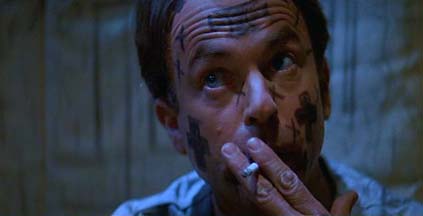 Sam Neill plays John Trent, a private investigator who specializes in insurance fraud. Trent is hired to investigate a large claim made by Arcane Books, a publishing house specializing in the horror genre, regarding the disappearance of their cash cow Sutter Cane (Jürgen Prochnow). Cane, presented here as an author writing in the manner of Lovecraft but with the popularity of Stephen King, has seemingly vanished from the face of the earth with the unfinished manuscript of his latest book, and Trent must either find out where Cane is if he’s alive or bring the book back to Arcane if Cane is, as presumed, dead. Accompanied by Cane’s editor Linda Styles (Julie Carmen), Trent travels to the New England town of Hobb’s End, the supposedly fictional locale for Cane’s novels (think Lovecraft’s Arkham or King’s Castle Rock), where he finds people and places that have been seemingly plucked from the pages of Cane’s stories. Determined to expose Hobb’s End and Cane for the frauds that he believes they are, Trent slowly finds himself a character in Cane’s newest story as the lines between fiction and reality are erased.
Sam Neill plays John Trent, a private investigator who specializes in insurance fraud. Trent is hired to investigate a large claim made by Arcane Books, a publishing house specializing in the horror genre, regarding the disappearance of their cash cow Sutter Cane (Jürgen Prochnow). Cane, presented here as an author writing in the manner of Lovecraft but with the popularity of Stephen King, has seemingly vanished from the face of the earth with the unfinished manuscript of his latest book, and Trent must either find out where Cane is if he’s alive or bring the book back to Arcane if Cane is, as presumed, dead. Accompanied by Cane’s editor Linda Styles (Julie Carmen), Trent travels to the New England town of Hobb’s End, the supposedly fictional locale for Cane’s novels (think Lovecraft’s Arkham or King’s Castle Rock), where he finds people and places that have been seemingly plucked from the pages of Cane’s stories. Determined to expose Hobb’s End and Cane for the frauds that he believes they are, Trent slowly finds himself a character in Cane’s newest story as the lines between fiction and reality are erased.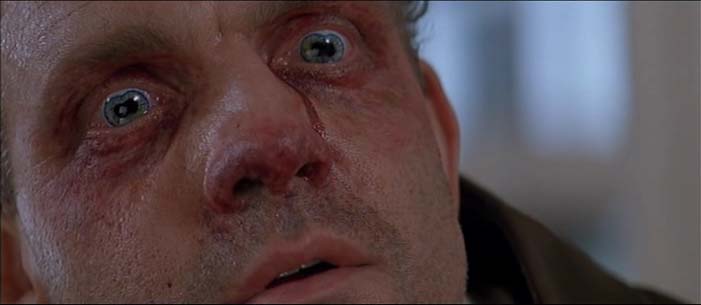 I’ve read some reviews of IN THE MOUTH OF MADNESS that disparage the notion of the film as being Lovecraftian, citing the minimal screen time given to showing the audience the horrible fanged and tentacled monsters that are such a large part of Lovecraft’s iconography, as well as the film’s focus on the earthly powers of Sutter Cane rather than the cosmic horror of the Old Ones. But to my thinking ITMOM perfectly captures the effect that H.P. Lovecraft has on his readers—in essence, the movie is a tribute to what it’s like to read a Lovecraft story. The brief glimpses the audience gets of Cane’s Old Ones mirror the tantalizing descriptions that HPL gave of his beasties in his work; we never get a full picture in either case, which allows our minds to fill in the rest of the horror. And the power that Cane has on his readers is not unlike the effect of Lovecraft’s own prose. “They all seem to have the same plot: slimy things in the dark, people go mad, they turn into monsters,” Trent muses on the phone to his client. “The funny thing is that they’re kind of better written than you’d expect, they sort of get to you, in a way. I don’t know if it’s his style of writing or use of description…” I have the same reaction to Lovecraft’s work, and as for fiction having power to alter reality, all I can say is that I’ll never again read Lovecraft in the midst of running a high fever. Talk about fucked-up dreams…
I’ve read some reviews of IN THE MOUTH OF MADNESS that disparage the notion of the film as being Lovecraftian, citing the minimal screen time given to showing the audience the horrible fanged and tentacled monsters that are such a large part of Lovecraft’s iconography, as well as the film’s focus on the earthly powers of Sutter Cane rather than the cosmic horror of the Old Ones. But to my thinking ITMOM perfectly captures the effect that H.P. Lovecraft has on his readers—in essence, the movie is a tribute to what it’s like to read a Lovecraft story. The brief glimpses the audience gets of Cane’s Old Ones mirror the tantalizing descriptions that HPL gave of his beasties in his work; we never get a full picture in either case, which allows our minds to fill in the rest of the horror. And the power that Cane has on his readers is not unlike the effect of Lovecraft’s own prose. “They all seem to have the same plot: slimy things in the dark, people go mad, they turn into monsters,” Trent muses on the phone to his client. “The funny thing is that they’re kind of better written than you’d expect, they sort of get to you, in a way. I don’t know if it’s his style of writing or use of description…” I have the same reaction to Lovecraft’s work, and as for fiction having power to alter reality, all I can say is that I’ll never again read Lovecraft in the midst of running a high fever. Talk about fucked-up dreams…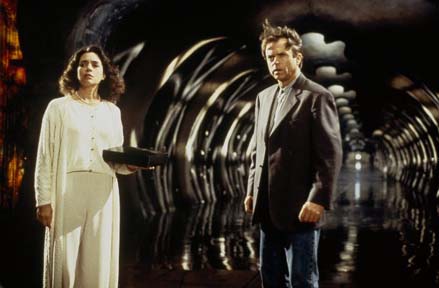 Even for those who have never read Lovecraft, IN THE MOUTH OF MADNESS is great fun. Neill plays the skeptic to perfection; his obstinate refusal to accept the mounting horrors he finds in Hobb’s End as reality give Trent his own brand of personal madness that winds up being just as terrifying for him as the madness created by Cane’s books. Carmen’s Styles has less of a dramatic journey—being Cane’s editor, Styles has already read some of Cane’s manuscript and is halfway under his spell by the time she and Trent reach Hobb’s End—but her glassy-eyed, slightly off-kilter performance adds to the sense of a world that’s not quite the reality we know. The supporting cast is fine, especially the late Frances May as the deceptively kindly and sweet hotel owner Mrs. Pickman. You might recognize May from her role as Adam Sandler’s grandmother in HAPPY GILMORE, but May puts her experience at playing the surreal in David Lynch’s films (BLUE VELVET, TWIN PEAKS: FIRE WALK WITH ME) to good use here as Mrs. Pickman is gradually revealed to be anything but kindly and sweet.
Even for those who have never read Lovecraft, IN THE MOUTH OF MADNESS is great fun. Neill plays the skeptic to perfection; his obstinate refusal to accept the mounting horrors he finds in Hobb’s End as reality give Trent his own brand of personal madness that winds up being just as terrifying for him as the madness created by Cane’s books. Carmen’s Styles has less of a dramatic journey—being Cane’s editor, Styles has already read some of Cane’s manuscript and is halfway under his spell by the time she and Trent reach Hobb’s End—but her glassy-eyed, slightly off-kilter performance adds to the sense of a world that’s not quite the reality we know. The supporting cast is fine, especially the late Frances May as the deceptively kindly and sweet hotel owner Mrs. Pickman. You might recognize May from her role as Adam Sandler’s grandmother in HAPPY GILMORE, but May puts her experience at playing the surreal in David Lynch’s films (BLUE VELVET, TWIN PEAKS: FIRE WALK WITH ME) to good use here as Mrs. Pickman is gradually revealed to be anything but kindly and sweet.Carpenter puts all his expertise to great use, creating a movie that manages to be atmospheric while still providing the requisite jump-scares, a movie that makes you think while at the same time winking at the audience with sly humor. Best of all, IN THE MOUTH OF MADNESS takes the experience of reading H.P. Lovecraft and brings it to the screen in a way that no strict Lovecraft adaptation has ever managed to do. For those horror fans out there who have somehow missed this film (which wouldn’t be altogether surprising, since it bombed at the box office before becoming a sort of a cult hit on video and DVD), I highly recommend watching this underappreciated John Carpenter gem that pays tribute to one of the fathers of the modern horror story.
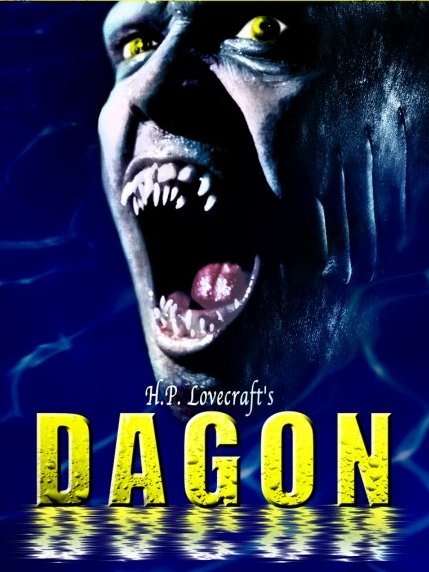
DAGON (2001)
Directed by Stuart GordonWritten by H.P. Lovecraft (short stories), Dennis Paoli (screenplay)
Starring Ezra Godden, Francisco Rabal, Raquel Meroño, Macarena Gómez, Brendan Price, Birgit Bofarull, Ferran Lahoz, Joan Minguell, Alfredo Villa
Reviewed by Ambush Bug
No stranger to Lovecraftian adaptations, Stuart Gordon’s most recent foray into the territory ruled by Cthulhu was DAGON, a flawed but effective little offering from a time when straight to video didn’t translate to piece of shit. Much like RE-ANIMATOR, FROM BEYOND, and CASTLE FREAK, I caught DAGON on video many moons ago. And while DAGON wasn’t as popular as Gordon’s other films, it still has a lot of redeeming qualities while continuing the tone set in Gordon’s previous works.
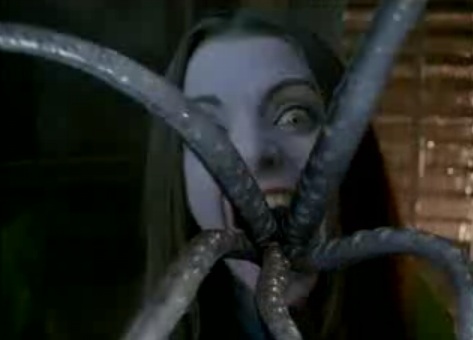 Combining the elements of two Lovecraft tales, DAGON and SHADOW OVER INNSMOUTH, Gordon introduces the film with an underwater dream sequence as our hero, Paul (Ezra Godden), discovers both an underwater civilization while scuba diving and a toothy mermaid. He awakens from the dream to find himself on a boat with his new wife Barbara (Raquel Meroño) and parents. When the ship accidentally crashes into a reef, Paul and Barbara have to row to shore in a raft in order to come back for help. The small town on the shore looks harmful, but behind the inhabitants’ heavy coats and wrappings are monsters.
Combining the elements of two Lovecraft tales, DAGON and SHADOW OVER INNSMOUTH, Gordon introduces the film with an underwater dream sequence as our hero, Paul (Ezra Godden), discovers both an underwater civilization while scuba diving and a toothy mermaid. He awakens from the dream to find himself on a boat with his new wife Barbara (Raquel Meroño) and parents. When the ship accidentally crashes into a reef, Paul and Barbara have to row to shore in a raft in order to come back for help. The small town on the shore looks harmful, but behind the inhabitants’ heavy coats and wrappings are monsters.Unlike many Lovecraft adaptations, Gordon seemed to add a big to gallows humor and sly wit to his adaptations. This was most evident in RE-ANIMATOR which had both laugh out loud moments and moments that made your hair stand on end. With DAGON, the humor is somewhat uneven and I don’t know if it works as effectively, but it does open up the story to be more relatable than other Lovecraft adaptations I’ve seen.
 Here the main character of Paul is played rather nebbishly by Ezra Godden. Instantly it’s obvious that Barbara is way out of his league and as this is never really expanded upon, the casting seems way off. Since the main conflict has Paul searching for his lost wife, not believing that the two would ever be together in a million years proves to be a bit of a distraction throughout the film. Still, Godden plays Paul as clumsy and awkward. This sometimes works, as with a thrilling sequence inside of a hotel room as Paul attempts to keep a horde of monstrous villagers at bay inside of his hotel room. But other times, it seems incompatible with the tone of the dire story playing out. The fact that Paul quickly forgets his wife when the seductive mermaid (Macarena Gómez) from his dream shows up doesn’t help in building the strength of the couple’s relationship.
Here the main character of Paul is played rather nebbishly by Ezra Godden. Instantly it’s obvious that Barbara is way out of his league and as this is never really expanded upon, the casting seems way off. Since the main conflict has Paul searching for his lost wife, not believing that the two would ever be together in a million years proves to be a bit of a distraction throughout the film. Still, Godden plays Paul as clumsy and awkward. This sometimes works, as with a thrilling sequence inside of a hotel room as Paul attempts to keep a horde of monstrous villagers at bay inside of his hotel room. But other times, it seems incompatible with the tone of the dire story playing out. The fact that Paul quickly forgets his wife when the seductive mermaid (Macarena Gómez) from his dream shows up doesn’t help in building the strength of the couple’s relationship.What works, though, is the setting and atmosphere. Constantly raining and gloomy, the streets of the harbor town are as scaly as the monsters themselves. Most likely filmed in Europe, Gordon takes full advantage of the surroundings making the harbor town a monster in itself with hidden traps and uneven streets and buildings.
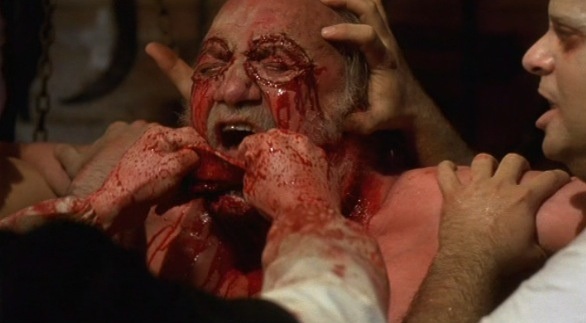 This film also excels in the fact that it uses mostly practical effects to full effect here. The monsters of the harbor town are subtle, covered in rain slickers and heavy coats. Only when the coats are flung off do we see that they are not of this world. The effects, overseen by Montse Boqueras (who did work on THE OTHERS) and David Martí (whose genius went on to films such as PAN’S LABYRINTH, THE ORPHANAGE, HELLBOY II, and most recently THE SKIN I LIVE IN), are misleading, making the people look slightly inhuman at first glance—all out monsters after a closer look. The final scenes as a man’s face is peeled away and the monsters show themselves is a terrifying sight to see. With 2001 being very early for CGI effects, the ones used here are painfully obvious and mostly distracting, especially since the practical effects are so good.
This film also excels in the fact that it uses mostly practical effects to full effect here. The monsters of the harbor town are subtle, covered in rain slickers and heavy coats. Only when the coats are flung off do we see that they are not of this world. The effects, overseen by Montse Boqueras (who did work on THE OTHERS) and David Martí (whose genius went on to films such as PAN’S LABYRINTH, THE ORPHANAGE, HELLBOY II, and most recently THE SKIN I LIVE IN), are misleading, making the people look slightly inhuman at first glance—all out monsters after a closer look. The final scenes as a man’s face is peeled away and the monsters show themselves is a terrifying sight to see. With 2001 being very early for CGI effects, the ones used here are painfully obvious and mostly distracting, especially since the practical effects are so good.While the movie lacks the powerful performances of Gordon’s RE-ANIMATOR and FROM BEYOND, the strength of the effects and the atmosphere, coupled with Gordon’s tight and tense directing of some key scenes makes DAGON well worth seeking out.
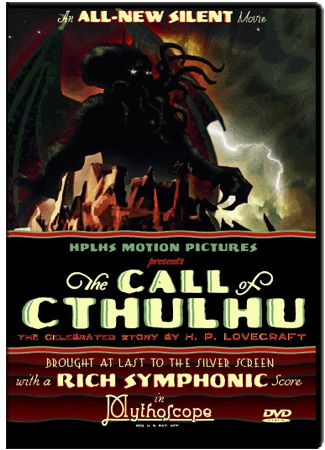
CALL OF CTHULHU (2005)
Directed by Andrew LemanWritten by H.P. Lovecraft (short story), Sean Branney (adapted for the screen by)
Starring Matt Foyer, John Bolen, Ralph Lucas, Chad Fifer, John Klemantaski, Jason Owens, D. Grigsby Poland, David Mersault, Barry Lynch, Daryl Ball, John Joly, Jason Peterson
Find out more about this film here!
Reviewed by Ambush Bug
After reviewing THE WHISPERER IN THE DARKNESS a few weeks ago,
I figured I’d take a look at another Lovecraft gem put to celluloid. Though this film has been out a couple of years, it still is one fans of unknown terrors might have missed when it was first released. Like WHISPERER, THE CALL OF CTHULHU is a throwback film made as if it were a silent era film. Also like that film, THE CALL OF CTHULHU shows a deep-seated respect for Lovecraft’s work, something filmmakers wanting to put their own personal stamp on the mythos seem to forget.
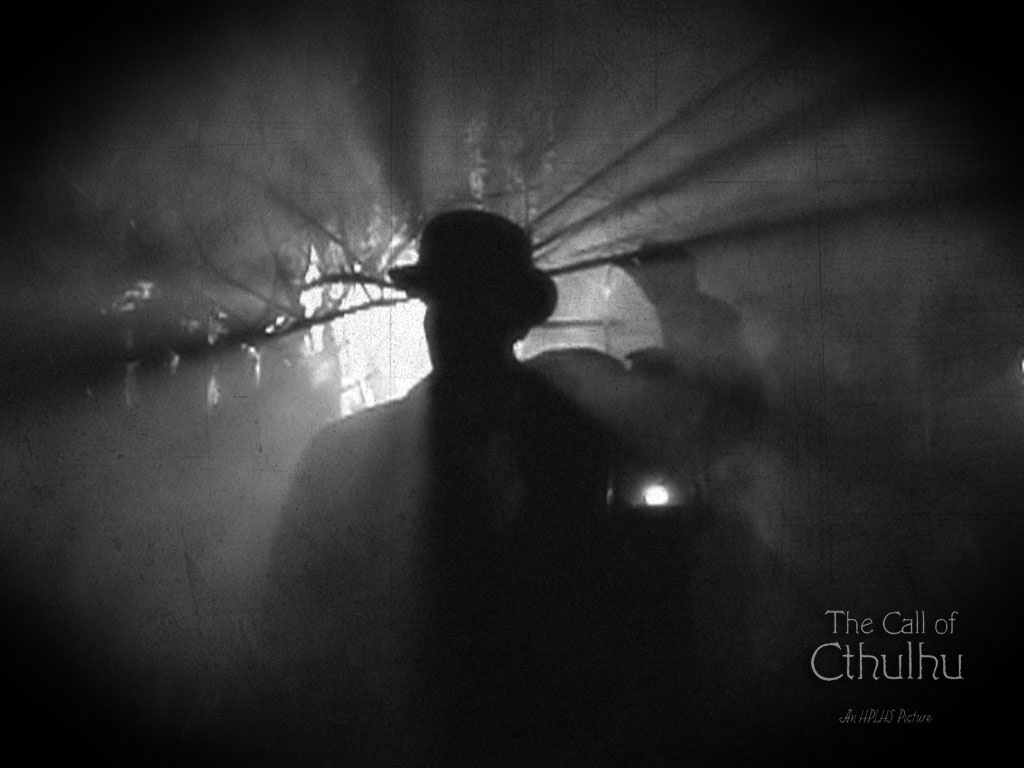 THE CALL OF CTHULHU, as far as what I remember of the original tale by Lovecraft, is an extremely faithful adaptation. Unlike other takes on Lovecraft’s work which seem to feel the unnecessary need to change story elements, this one sticks pretty close to Lovecraft’s classic story. The story focuses on multiple accounts found during an investigation into some paperwork a young man finds in a deceased relative’s belongings. The stories recount a cult tied to murder and other mayhem that lies just under the radar of the general public. Though these stories reek of the conspiratorial rantings of a madman, the journal entries talk of midnight rituals and otherworldly gods.
THE CALL OF CTHULHU, as far as what I remember of the original tale by Lovecraft, is an extremely faithful adaptation. Unlike other takes on Lovecraft’s work which seem to feel the unnecessary need to change story elements, this one sticks pretty close to Lovecraft’s classic story. The story focuses on multiple accounts found during an investigation into some paperwork a young man finds in a deceased relative’s belongings. The stories recount a cult tied to murder and other mayhem that lies just under the radar of the general public. Though these stories reek of the conspiratorial rantings of a madman, the journal entries talk of midnight rituals and otherworldly gods.The film itself jumps all over the place, from a backwoods ritual site to a prison to an insane asylum to a boat lost at sea. But as I recall, so does the original story, which is more of a collection of recounts by witnesses. Through these multiple stories, though, there is one constant thread—there is a dark god named Cthulhu and he wants to enter our world.
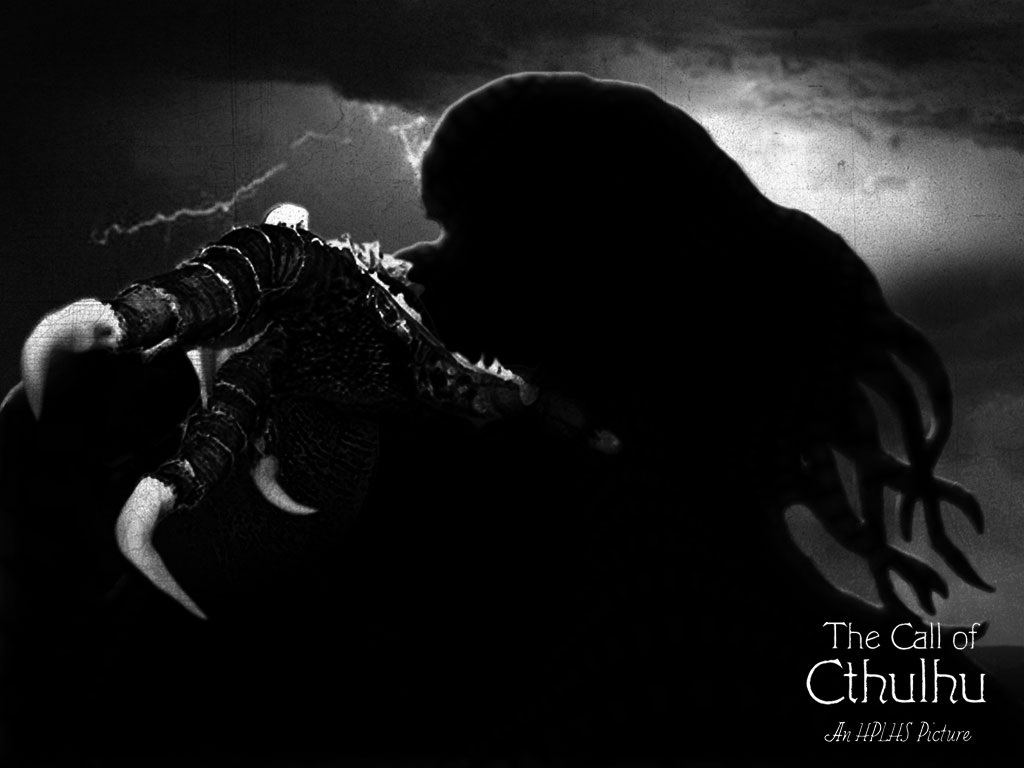 The choice to film this both in black and white and silently was a good one. There’s something to the grainy quality of this film that makes it all the more convincing, yet the effects and acting throughout are much more convincing than one would expect of a film made in this manner. The stop motion Cthulhu is most ambitious, and pretty convincing in a Harryhausen sort of way. I was even more intrigued by the story of the police raid on the cult deep in the woods. This scene reminded me a lot of Indiana Jones and Short Round happening upon Mola Rom’s heart-ripping scene in TEMPLE OF DOOM.
The choice to film this both in black and white and silently was a good one. There’s something to the grainy quality of this film that makes it all the more convincing, yet the effects and acting throughout are much more convincing than one would expect of a film made in this manner. The stop motion Cthulhu is most ambitious, and pretty convincing in a Harryhausen sort of way. I was even more intrigued by the story of the police raid on the cult deep in the woods. This scene reminded me a lot of Indiana Jones and Short Round happening upon Mola Rom’s heart-ripping scene in TEMPLE OF DOOM.While capturing the thrills of the Saturday afternoon serial with modern effects and performances, THE CALL OF CTHULHU is another adaptation of Lovecraft’s works that fans of the author can be most proud of. If you long for old timey scares, it would behoove you to make THE CALL OF CTHULHU part of your collection.
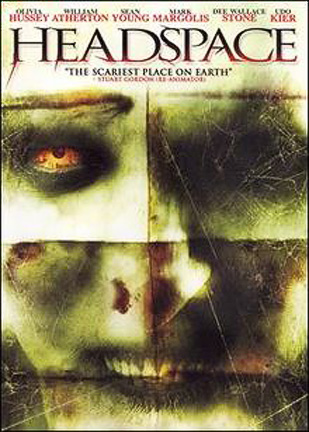
HEADSPACE (2005)
Directed by Andrew van den HoutenWritten by Steve Klausner, Troy McCombs, William M. Miller
Starring Christopher Denham, Erick Kastel, Olivia Hussey, William Atherton, Sean Young, Mark Margolis, Larry Fessenden, Dee Wallace Stone, Udo Kier
Reviewed by BottleImp
Remember a few years ago when Blockbuster Video started to implode and close its stores? As location after location began to sell off inventory in preparation for closure, I managed to pick up a lot of DVDs on the cheap. Most of them were movies that I had seen, but on a couple of occasions I took a chance on something new—what the hell, it was only a couple of bucks. One such movie I bought based on its impressive lineup of actors, cited horror film festival awards, and a blurb from director Stuart Gordon emblazoned on the DVD case. This movie was the Lovecraftian psychological thriller HEADSPACE.
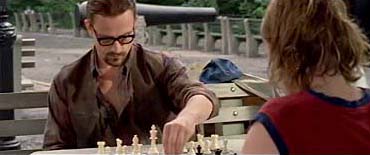 The film begins with an in-your-face, as yet unexplained shot of a bloodstained young man clad in a hospital johnny staggering to a chess table in an uninhabited, desolate-looking park. This striking visual abruptly cuts to an idyllic family scene as a young boy’s birthday is celebrated with his brother and parents, though the pleasant vista shifts to an ominous tone as the mother (Sean Young) experiences an inexplicable nosebleed. From there, the mood grows even darker as, in a dreamlike scene, the boys find their bloodstained mother with the mutilated carcass of the family dog in her lap. The tension escalates to one of the film’s most effective moments of horror before cutting back to the present day, where a young man named Alex Borden (Christopher Denham) happens upon a chess game in the park. Alex sits down and is almost immediately checkmated, and as he shakes hands with his opponent Harry Jellenik (Erick Kastel), Alex experiences a sudden headache and brief flash of a bizarre vision. These headaches grow more intense and the visions more persistent, but along with them Alex’s mental facilities begin to expand. He becomes able to instantly absorb information and solve complicated mathematical equations, but he experiences increasingly bizarre glimpses of his past (that’s right, Alex is one of the brothers from the prologue, and it’s fairly simple to guess who the other brother is) along with visions of murderous creatures that may or may not actually exist. As both visions and flashbacks become nearly constant, Alex is forced to face both his past and the threat of an unstoppable evil from an alien dimension…or is it all in his head?
The film begins with an in-your-face, as yet unexplained shot of a bloodstained young man clad in a hospital johnny staggering to a chess table in an uninhabited, desolate-looking park. This striking visual abruptly cuts to an idyllic family scene as a young boy’s birthday is celebrated with his brother and parents, though the pleasant vista shifts to an ominous tone as the mother (Sean Young) experiences an inexplicable nosebleed. From there, the mood grows even darker as, in a dreamlike scene, the boys find their bloodstained mother with the mutilated carcass of the family dog in her lap. The tension escalates to one of the film’s most effective moments of horror before cutting back to the present day, where a young man named Alex Borden (Christopher Denham) happens upon a chess game in the park. Alex sits down and is almost immediately checkmated, and as he shakes hands with his opponent Harry Jellenik (Erick Kastel), Alex experiences a sudden headache and brief flash of a bizarre vision. These headaches grow more intense and the visions more persistent, but along with them Alex’s mental facilities begin to expand. He becomes able to instantly absorb information and solve complicated mathematical equations, but he experiences increasingly bizarre glimpses of his past (that’s right, Alex is one of the brothers from the prologue, and it’s fairly simple to guess who the other brother is) along with visions of murderous creatures that may or may not actually exist. As both visions and flashbacks become nearly constant, Alex is forced to face both his past and the threat of an unstoppable evil from an alien dimension…or is it all in his head?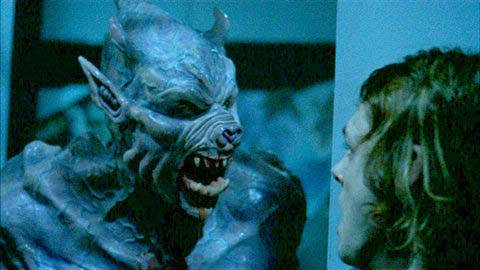 HEADSPACE explores the Lovecraftian theme of bridging the space between dimensions through the use of one’s mind rather than any sort of external paraphernalia. This idea of opening up doorways to alien vistas through mental experimentation can be found in HPL’s “Dreams in the Witch House” and “The Shadow Out of Time.” The expansion of one’s mental abilities through contact with other-dimensional beings was also a key component of Stuart Gordon’s FROM BEYOND, based loosely on Lovecraft’s story of the same name, and a probable influence on this film. There’s also a healthy hint of “Pickman’s Model” to be detected in HEADSPACE—at least, we Lovecraft fanatics will inevitably draw that comparison, given the brief glimpses the audience gets at Harry’s paintings…the ones that seem to depict monstrous creatures interacting with our own mundane reality. And it can’t just be a coincidence that when the monsters are finally fully revealed, they so closely resemble Lovecraft’s description of Pickman’s unearthly model, with its “dog face with its pointed ears, bloodshot eyes, flat nose, and drooling lips”? No, I’m going with the assumption that these elements were intentional decisions by the filmmakers, made to help give HEADSPACE that added atmosphere of cosmic horror by tapping into the Lovecraftian vein.
HEADSPACE explores the Lovecraftian theme of bridging the space between dimensions through the use of one’s mind rather than any sort of external paraphernalia. This idea of opening up doorways to alien vistas through mental experimentation can be found in HPL’s “Dreams in the Witch House” and “The Shadow Out of Time.” The expansion of one’s mental abilities through contact with other-dimensional beings was also a key component of Stuart Gordon’s FROM BEYOND, based loosely on Lovecraft’s story of the same name, and a probable influence on this film. There’s also a healthy hint of “Pickman’s Model” to be detected in HEADSPACE—at least, we Lovecraft fanatics will inevitably draw that comparison, given the brief glimpses the audience gets at Harry’s paintings…the ones that seem to depict monstrous creatures interacting with our own mundane reality. And it can’t just be a coincidence that when the monsters are finally fully revealed, they so closely resemble Lovecraft’s description of Pickman’s unearthly model, with its “dog face with its pointed ears, bloodshot eyes, flat nose, and drooling lips”? No, I’m going with the assumption that these elements were intentional decisions by the filmmakers, made to help give HEADSPACE that added atmosphere of cosmic horror by tapping into the Lovecraftian vein.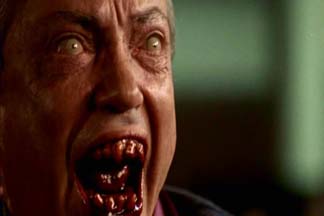 Unfortunately, HEADSPACE ends up being a movie full of atmosphere, but with frustratingly little payoff. Part of the problem is that the audience knows next to nothing about the characters; we’re told that Alex is currently housesitting and we see that Harry is an artist, but aside from that we know nothing about their present-day lives. In the case of the supporting cast we know even less. HEADSPACE boasts an impressive lineup of horror and sci-fi movie veterans for these parts, yet none of them are given more than ten minutes of screen time. Udo Kier (ANDY WARHOL’S DRACULA) has the most visually meaty scene, but his part ultimately amounts to a footnote in the plot. Olivia Hussey’s (BLACK CHRISTMAS) psychiatrist merely serves as a handy way for Alex to provide exposition, while Dee Wallace Stone (THE HOWLING) as one of the doctors who initially examines Alex seems so disconnected that she looks like she’s sleepwalking through her scenes. Pacing also becomes an issue as the film slows down and meanders about for the majority of the second act. The movie picks up again as Alex meets with discredited Russian scientist Boris Pavlovsky (Mark Margolis), who gives Alex and the audience an explanation for what is occurring. It seems that while working for the KGB, Pavlovsky experimented with people he dubbed “links,” who were able to bridge the gaps between parallel dimensions. Put two “links” together and you had the potential to create a psychic weapon…but it also creates an increased danger that can only be stopped by killing the “links.” But the deaths caused by the psychic power…are these indeed the work of extra-dimensional creatures, or are they caused by the psychics themselves?
Unfortunately, HEADSPACE ends up being a movie full of atmosphere, but with frustratingly little payoff. Part of the problem is that the audience knows next to nothing about the characters; we’re told that Alex is currently housesitting and we see that Harry is an artist, but aside from that we know nothing about their present-day lives. In the case of the supporting cast we know even less. HEADSPACE boasts an impressive lineup of horror and sci-fi movie veterans for these parts, yet none of them are given more than ten minutes of screen time. Udo Kier (ANDY WARHOL’S DRACULA) has the most visually meaty scene, but his part ultimately amounts to a footnote in the plot. Olivia Hussey’s (BLACK CHRISTMAS) psychiatrist merely serves as a handy way for Alex to provide exposition, while Dee Wallace Stone (THE HOWLING) as one of the doctors who initially examines Alex seems so disconnected that she looks like she’s sleepwalking through her scenes. Pacing also becomes an issue as the film slows down and meanders about for the majority of the second act. The movie picks up again as Alex meets with discredited Russian scientist Boris Pavlovsky (Mark Margolis), who gives Alex and the audience an explanation for what is occurring. It seems that while working for the KGB, Pavlovsky experimented with people he dubbed “links,” who were able to bridge the gaps between parallel dimensions. Put two “links” together and you had the potential to create a psychic weapon…but it also creates an increased danger that can only be stopped by killing the “links.” But the deaths caused by the psychic power…are these indeed the work of extra-dimensional creatures, or are they caused by the psychics themselves?Ultimately, the question is never answered as to whether these otherworldly monsters are really there or just part of Alex’s madness, and that’s what keeps this film from being effective. It’s fine if a movie leaves its audience with questions at the end, but in this case it feels more like the makers of HEADSPACE didn’t have a clear idea themselves about the answers to those questions. Nevertheless, HEADSPACE does provide a moody atmosphere that can be hard to find in today’s horror genre, and manages to evoke a touch of the Lovecraftian tone, if only for a few moments. I’m glad that I got this movie for the cost of a rental; I wouldn’t recommend paying full price for the DVD (a new, shorter director’s cut is coming this June—maybe that’ll take care of that slow second act?), but HEADSPACE is definitely worth a watch for Lovecraft fans.

THE WHISPERER IN THE DARKNESS (2011)
Directed by Sean BranneyWritten by H.P. Lovecraft (story), Andrew Leman & Sean Branney (screenplay)Starring Matt Foyer, Barry Lynch, Daniel Kaemon, Matt Lagan, Joe Sofranko, Stephen Blackheart, David Pavao, & Autumn Wendel
Find out more about this film here!
Reviewed by Ambush Bug
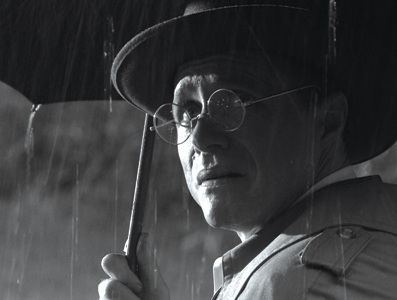 Those looking for Lovecraft done right should look no further than Sean Branney’s THE WHISPERER IN THE DARKNESS. I’ve read the story quite a few times, and though this story of otherworldly portals and demon bugs from other dimensions is not the most literal of Lovecraft’s work, I still don’t think that it’s been adapted perfectly. Until now. The filmmakers seem to not only possess the uncanny ability to translate Lovecraft’s words and themes with ease, but they also punch up the story with modern effects while giving it a timeless quality of the matinee serials.
Those looking for Lovecraft done right should look no further than Sean Branney’s THE WHISPERER IN THE DARKNESS. I’ve read the story quite a few times, and though this story of otherworldly portals and demon bugs from other dimensions is not the most literal of Lovecraft’s work, I still don’t think that it’s been adapted perfectly. Until now. The filmmakers seem to not only possess the uncanny ability to translate Lovecraft’s words and themes with ease, but they also punch up the story with modern effects while giving it a timeless quality of the matinee serials.It’s a simpler time, when men wore fedoras and suits everywhere and life was monochromatic. The film’s narrator Albert Wilmarth (played by Matt Foyer) is a scholar interested in having a philosophical debate about the existence of uncategorized beings not recognized by science. After receiving a summons from a townsperson in Vermont, he journeys to the man’s home only to encounter the very otherworldly beings he told himself didn’t exist.
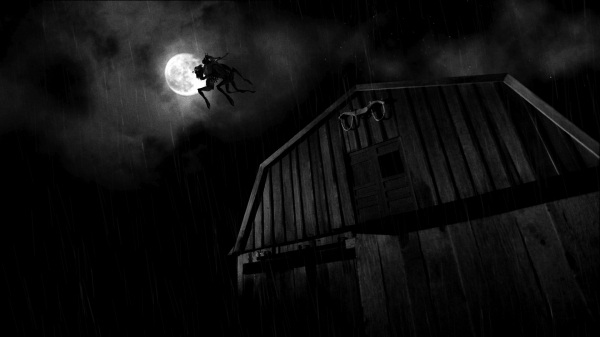 Though this film is heavy on the talk, the strong performances and full embrace of the monster movies of the fifties make every second of this film intriguing and unblinkable. Filmed in stark blacks, faded whites, and amorphous greys, THE WHISPERER IN THE DARKNESS is a monster movie for folks who miss going to monster movie matinees. Branney adapts this tale of science proved wrong sharply with quick line exchanges and every eerie trick in the book made to amp up the old timey thrills.
Though this film is heavy on the talk, the strong performances and full embrace of the monster movies of the fifties make every second of this film intriguing and unblinkable. Filmed in stark blacks, faded whites, and amorphous greys, THE WHISPERER IN THE DARKNESS is a monster movie for folks who miss going to monster movie matinees. Branney adapts this tale of science proved wrong sharply with quick line exchanges and every eerie trick in the book made to amp up the old timey thrills.Branney also incorporates modern CGI and practical effects to make this film experience seem as real as those old time movies were to you when you watched them as a child. The makers of this film’s love of Lovecraft is seen in every frame, and where most Lovecraftian films veer toward the more sensible or less bogged down by mythology, THE WHISPERER IN THE DARKNESS embraces the world of Lovecraft with all of its cryptic phrases and names.
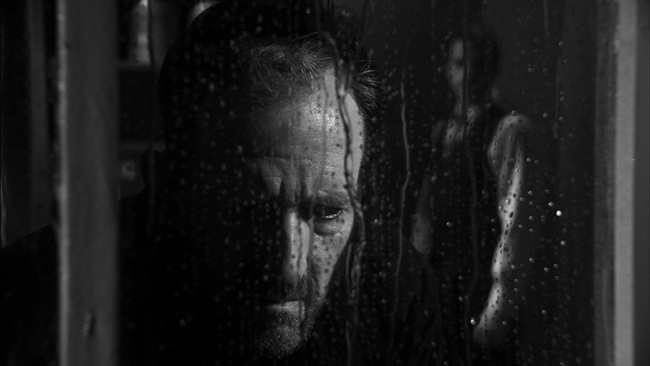 The heroics are daring, as is the music. As Albert reluctantly is forced into defending the earth, I could see the masses of the fifties loving the hell out of a film like this, tossing their popcorn in the air and gripping their loved ones. I loved every moment of this Saturday afternoon serial brought to life in the modern age. The effects are top tier, with mask-wearing alien bug creatures called the Mi-Go working with human cults attempting to open a portal so that their world can overtake our own. THE WHISPERER IN THE DARKNESS is the first Lovecraftian film done completely right and I can’t wait to see more from this production company, which has also adapted THE CALL OF CTHULHU (a film I have yet to see, but after seeing this one, can’t wait to do so).
The heroics are daring, as is the music. As Albert reluctantly is forced into defending the earth, I could see the masses of the fifties loving the hell out of a film like this, tossing their popcorn in the air and gripping their loved ones. I loved every moment of this Saturday afternoon serial brought to life in the modern age. The effects are top tier, with mask-wearing alien bug creatures called the Mi-Go working with human cults attempting to open a portal so that their world can overtake our own. THE WHISPERER IN THE DARKNESS is the first Lovecraftian film done completely right and I can’t wait to see more from this production company, which has also adapted THE CALL OF CTHULHU (a film I have yet to see, but after seeing this one, can’t wait to do so).It’s about damn time they got Lovecraft right.
And finally…here’s a haunting little short focusing on the writer himself, HP Lovecraft drawn by Leonardo Manna and directed by Michele Boitticelli. Though simplistic, it is a pretty effective little short. Enjoy, A LOVECRAFT DREAM!
See ya next week, folks!
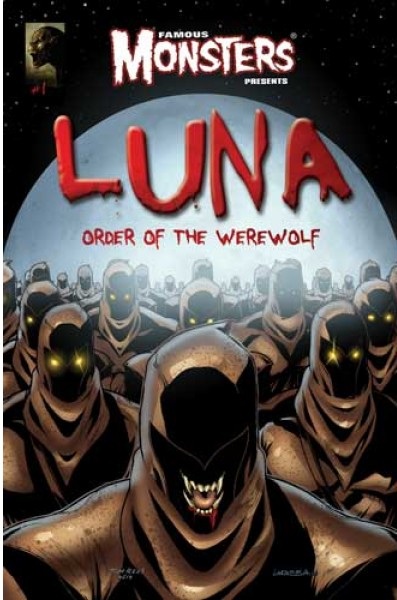
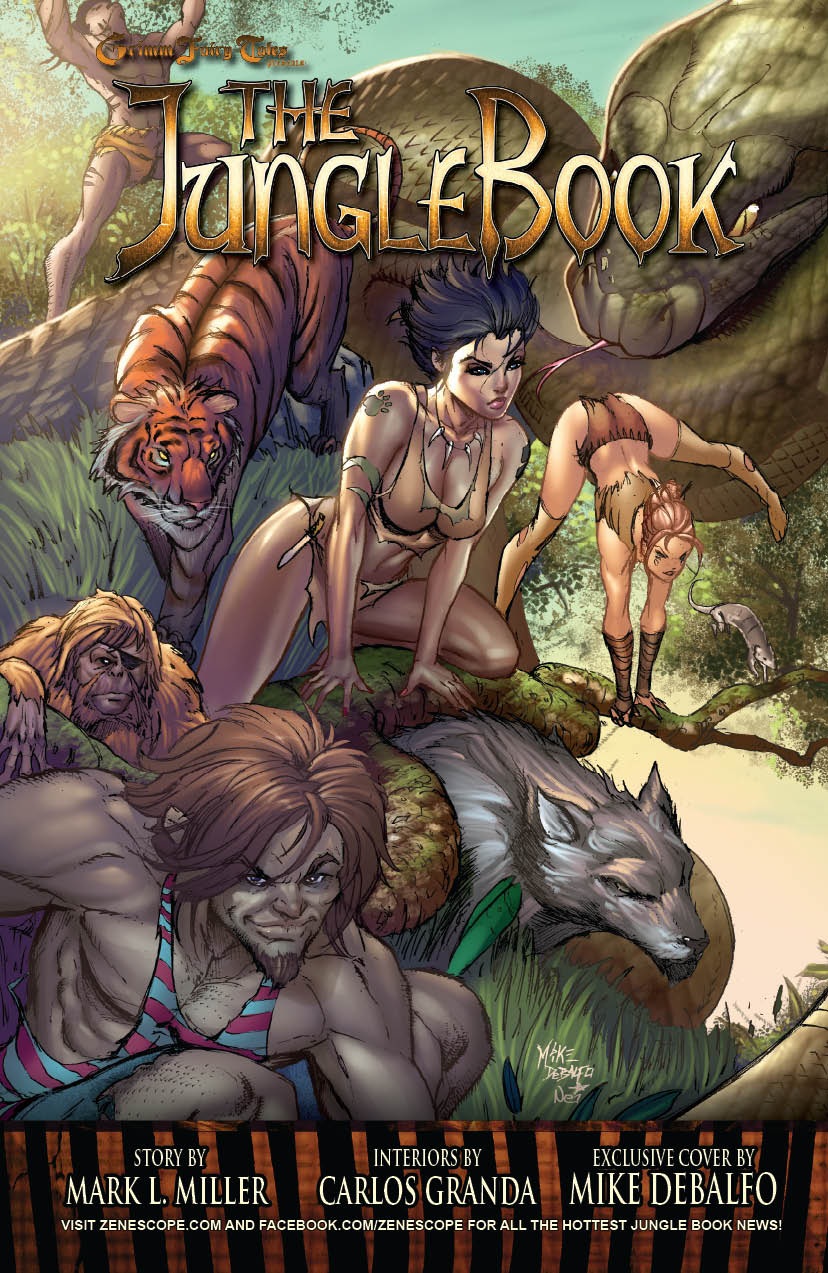 Ambush Bug is Mark L. Miller, original @$$Hole/wordslinger/reviewer/co-editor of AICN Comics for over ten years. He has written comics such as MUSCLES & FIGHTS, MUSCLES & FRIGHTS, VINCENT PRICE PRESENTS TINGLERS & WITCHFINDER GENERAL, THE DEATHSPORT GAMES, WONDERLAND ANNUAL 2010 & NANNY & HANK (soon to be made into a feature film from Uptown 6 Films). He is also a regular writer for FAMOUS MONSTERS OF FILMLAND & has co-written their first ever comic book LUNA: ORDER OF THE WEREWOLF (to be released in October 2012 as an 100-pg original graphic novel). Mark has just announced his new comic book miniseries GRIMM FAIRY TALES PRESENTS THE JUNGLE BOOK from Zenescope Entertainment to be released in March 2012.
Ambush Bug is Mark L. Miller, original @$$Hole/wordslinger/reviewer/co-editor of AICN Comics for over ten years. He has written comics such as MUSCLES & FIGHTS, MUSCLES & FRIGHTS, VINCENT PRICE PRESENTS TINGLERS & WITCHFINDER GENERAL, THE DEATHSPORT GAMES, WONDERLAND ANNUAL 2010 & NANNY & HANK (soon to be made into a feature film from Uptown 6 Films). He is also a regular writer for FAMOUS MONSTERS OF FILMLAND & has co-written their first ever comic book LUNA: ORDER OF THE WEREWOLF (to be released in October 2012 as an 100-pg original graphic novel). Mark has just announced his new comic book miniseries GRIMM FAIRY TALES PRESENTS THE JUNGLE BOOK from Zenescope Entertainment to be released in March 2012.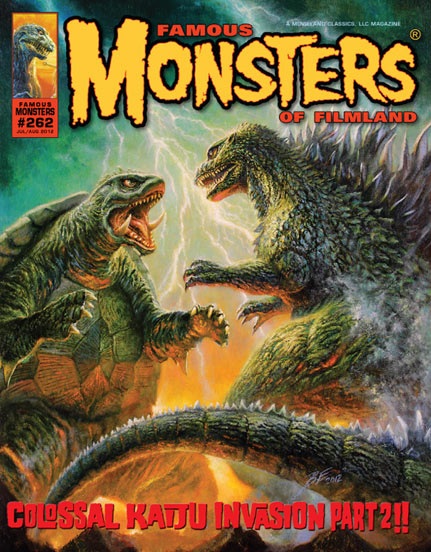
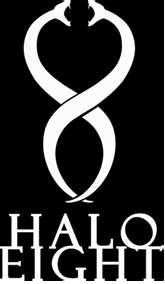
Interested in illustrated films, fringe cinema, and other oddities?
Check out Halo-8 and challenge everything!
Find more AICN HORROR including an archive of previous columns
on AICN HORROR’s Facebook page!
